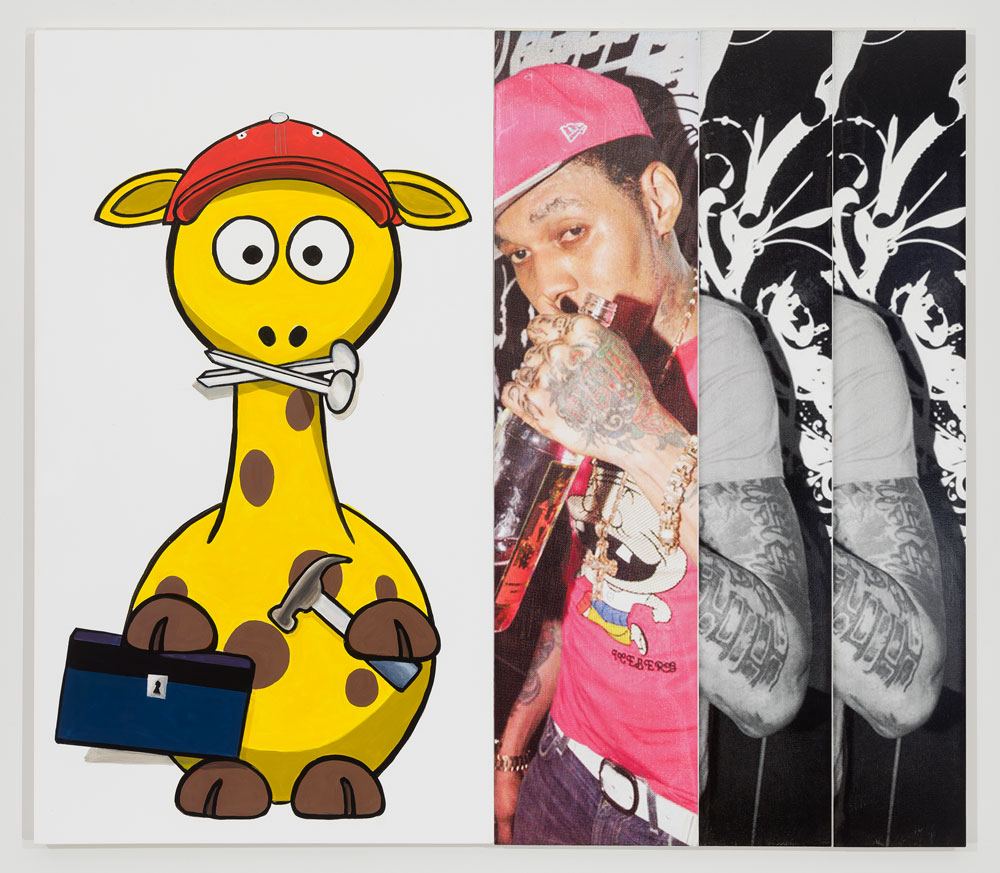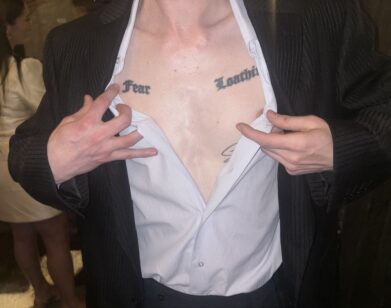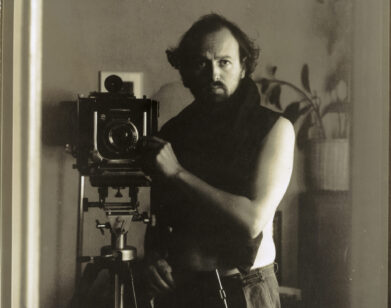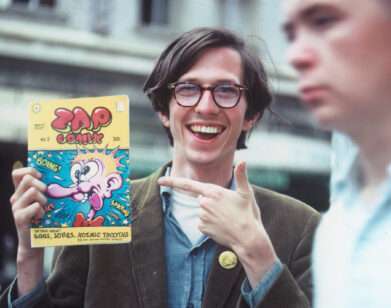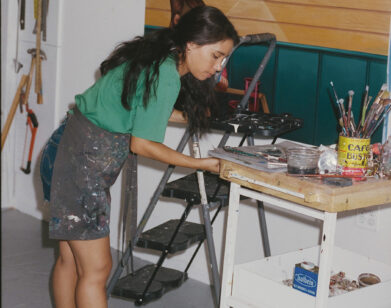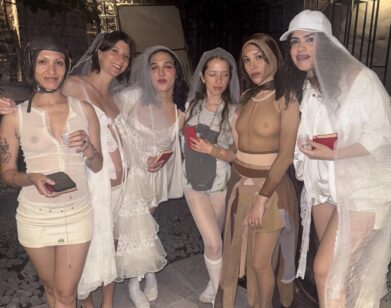Critically Thinking
Julia Wachtel developed her practice in New York in the 1980s, and the influences of artists like Andy Warhol and Sherrie Levine are clearly seen in artworks. The artist makes them her own, however, by pairing painted cartoons with silkscreen reproductions of pop culture imagery. And, while this approach could seem antiquated, Wachtel makes her works contemporary through her engagement with current topics, ranging from Kim, Kanye, and Miley to ISIS, Hillary Clinton, and Kim Jong-un. Currently on view at Elizabeth Dee Gallery in New York is “Empowerment,” a show offering six new paintings completed in the past year.
Upon walking into the space, viewers are greeted by North Korea’s dictator juxtaposed with South Korean internet sensation, Psy (responsible for “Gangnam Style”) on the left wall, while on the right, a screen-printed Hillary Clinton regally poses next to paintings of pre-historic sculptures in the shape of Venus. The two political figures hang directly opposite each other, and, when combined with Psy and the B.C. sculptures, force the viewer to consider current popular culture in relation to history, power, and politics.
“The larger project is to, in a full spectrum, represent the world,” the New York-based artist says. “If you see me as a landscape painter, then I’m painting a city, a farm, a factory, a war.”
Wachtel’s consideration of images has evolved with time. She started as a sculpture major at Middlebury College, where she made assemblages and tombstone-like sculptures, but then received her MFA from the School of Visual Arts in New York, where, she says, she became more conceptually minded. Since then, the artist has progressed from painting appropriated images to incorporating silkscreen and creating more narratives and coherency within the works and her chosen juxtapositions. A few days after the opening of “Empowerment,” we spoke with Wachtel at Elizabeth Dee.
EMILY MCDERMOTT: The first piece you made for this show was Stripe, with Kim Jong-un, right? It’s interesting having him and Hillary Clinton stare at each other across the room.
JULIA WACHTEL: Correct, but I generate drawings and plans for the pieces, and I work on multiple pieces at the same time. The Hillary Clinton one was at about the same time. I came up with the idea for Kim Jong-un and I wanted to balance it out—not seem so cynical—with someone who I admire.
MCDERMOTT: What made you want to focus on Kim Jong-un to begin with?
WACHTEL: When I do a painting, a lot of different things initiate the start. Sometimes I have a super clear idea and I go after it. Like, I wanted to do a painting of Hillary Clinton, so I searched for [images of] Hillary Clinton. Other times, other things get me there. In the case of that painting, Stripe, I was actually interested in memes. The originating point for the image search wasn’t Kim Jong-un; it was this meme culture. I knew that “Gangnam Style” was, and still is, the most viewed video in the history of YouTube, so I found all these memes and had this idea of Kim Jong-un. Of course, it’s so Warholian; it reminds me of Warhol’s Mao paintings in a ridiculous way. So, there was the obvious connection between North and South Korea—the idea of a viral video being the embodiment of free circulation of expression, versus the completely repressive regime. It was extremely obvious, almost didactic, but I thought it was hilarious, image-wise.
MCDERMOTT: It’s interesting that you work on multiple pieces at once. For some artists that’s really hard to do.
WACHTEL: I used to only work on one piece at a time and I would love the luxury of doing that. But, if you have the pressures of exhibitions, and now art fairs, you’d get nothing done if you just worked on one piece at a time. So I work on the drawings, the studies that I do in InDesign, continuously. Then they go up on my wall and as I commit to making a piece, then I put the [silkscreen] panels into production, order the stretcher, and it takes more than a month before it’s delivered. A lot of the work with silkscreen is preparing it on canvases and I have an assistant who does that. Then I usually block out a week and do four or five paintings. So I go from having nothing to a full studio. It’s kind of like Christmas—you’ve ordered all the presents, then Amazon delivers it, and there they are!
MCDERMOTT: I know you originally were only painting, and then adopted screen printing. What initiated that change?
WACHTEL: I actually started screen printing like a month after Warhol died in 1987. The work was always about pop culture, but I never really thought to make screen prints. It didn’t even occur to me. Warhol was probably the most important influence on me, but as I said, I wasn’t thinking, “That’s a process I want to use.” Then, after he died, I thought, “Oh, this process is available to me.” I don’t think I would’ve ever made silkscreen prints while he was making work, because you would just be in the shadow of him. Once he died, it was like, “This is a tool I can use,” and it seemed very adaptable to what I was doing. The first image I did was actually Janis Joplin, a very pop image.
MCDERMOTT: Growing up, what was the first piece of art you saw that made you realize you could take pop culture imagery and turn it into something else?
WACHTEL: I remember it very clearly. It was Roy Lichtenstein. I was in high school, and I had always made art—as a kid I always liked to paint and draw—but my senior project was an art project. I didn’t live in a [bubble]—I traveled around with my parents, had been to Europe, lived in the suburbs of New York—but I had never been to MoMA. So [I finally went in high school] and saw the Roy Lichtenstein painting Girl with a Beach Ball. It was a revelation. It was like separation at birth, a kindred spirit. I just couldn’t believe the painting. Seeing it…it’s so painterly. That was the first painting I saw that made me think, “I can be an artist.”
MCDERMOTT: Where did you go from there?
WACHTEL: I started making, in my first year of college at Middlebury, Rauschenberg-y assemblage things and then I became aware of minimalism. I was looking at Donald Judd and making minimalist, cube structures that were built and wrapped in black plastic. Then I went to SVA and studied with Joseph Kosuth, Vito Acconci, and Joan Jonas. I became much more conceptual-minded, but it was always connected to a pop vernacular. That’s been consistent from when I was 10 until now. Not much has changed.
MCDERMOTT: I like what you’ve said in interviews before, that you consider your work to act like a speed bump.
WACHTEL: I could make photographs, but I very purposefully make paintings because paintings, ideally, should slow you down. I put benches in the gallery to encourage people to sit down and spend more time. Everyone’s always in a rush and speeding around, but a painting should be an object of contemplation, something you can sit with. You should keep looking at it over time and things will reveal themselves.
When I started making appropriation work and entered into the gallery system, no one was painting appropriations. There was painting going on, like Julian Schnabel and neo-abstract painting and graffiti art, but no one was doing critical theory and appropriation paintings. It was considered a bad thing to do, because painting was associated with the market and institutional authority and other ideas that critically minded people were trying to deconstruct. It was a real act of perversity on my part to decide that painting was going to be the platform I would engage in these ideas.
MCDERMOTT: So did you receive a lot of criticism when you first emerged?
WACHTEL: The work was well received, but it wasn’t really well received in the market. It was a little rough for collectors to want to have these really goofy, pathetic, cartoon characters. They were the kind of images people wanted to disassociate, not associate, themselves with. I intentionally used them because I was trying to undercut the un-critical identification with glamour. You can be Richard Prince and take reproduced serial images and deconstruct the power of those images, but if you do it with the same glossiness, you retain the patina and the aura of the glamour. I was trying to say, “I’m not going that route. I’m not going to reinvest in the thing you guys are trying to criticize.” I think that made it hard for collectors to get behind.
MCDERMOTT: How do you feel personally about popular culture and its proliferation?
WACHTEL: You know, if you’re a fireman, I think you love fire, even if you’re trying to put the fire out. That would be a very good analogy to my relationship with pop culture. I love it, but it’s obviously extremely powerful, in a lot of negative ways, in terms of identity and self, particularly for women. Not exclusively women, but young girls, with the internet—YouTube and videos about image and concerns, there’s pro-bulimia websites. It’s not just pop culture now; it’s social media. A lot of it is user-generated, but it’s reproducing like a virus. The term viral is apt. But I love pop culture, too. I love the Gangnam video.
MCDERMOTT: When you’re working on paintings, do you see them as a collection that you’re going to show together or do you seem them individually?
WACHTEL: For this show, I did think of it as a collection. I curated the drawings to put together a group for an exhibition. Not that they’re similar, but I wanted to have a full spectrum of what I do and have them work together. But when my London gallery, Vilma Gold, and Elizabeth Dee go to the art fair, that work is not seen as a group.
MCDERMOTT: With the increased number and relative importance of fairs, what’s it like knowing that you have to create work, rather than making it from your own will?
WACHTEL: It’s not good. I mean, thank god it’s an opportunity to sell my work, so I can’t complain, but it’s like, I hate having to buy a dress because I’m going to a wedding. Do I like buying dresses? Yes, but under the right circumstances.
MCDERMOTT: You also worked at Vanity Fair as the production manager for the U.K. edition and on the U.S. side of things as well. How did that impact your personal work or vice versa?
WACHTEL: The funny thing about working at Vanity Fair is that I have some kind of facial dyslexia. I can’t distinguish one white actress from another. [laughs] Kate Hudson could be on the cover and I would have no idea who it was. It’s hilarious that I’m working with celebrities, I’m working with images, and I can’t even tell one from the other. But I have to say, I miss the camaraderie of an office environment. It’s nice to work with other people in a collaborative way.
“EMPOWERMENT” IS ON VIEW AT ELIZABETH DEE GALLERY IN CHELSEA THROUGH JUNE 27. FOR MORE ON THE ARTIST, VISIT HER WEBSITE.

